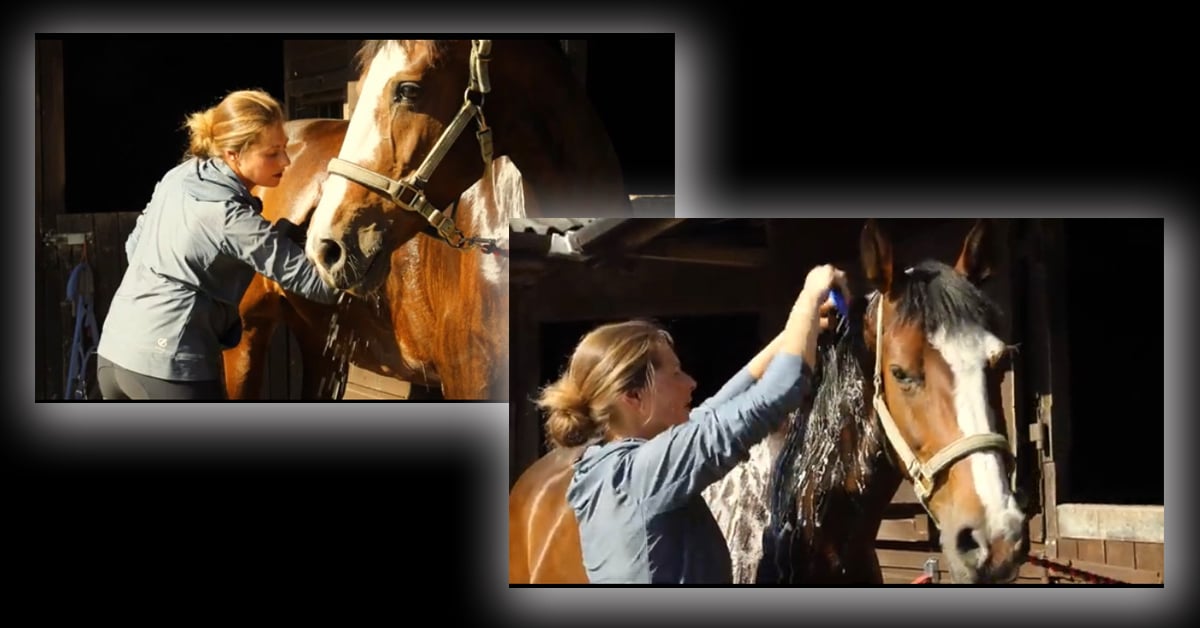Ever wonder why you’re so captivated when you stumble across a video of a dirty mane getting shampooed, a hoof being picked out, or a coat being clipped, even if you’ve done it a million times in person? Whether you’re a seasoned tinglehead, or you’ve never heard the acronym ASMR before, if you’ve ever been fascinated by horse grooming videos, you may have experienced horse grooming ASMR.
ASMR, or autonomous sensory meridian response, is a physical reaction in the body produced through paying close attention to pleasant audiovisual stimuli found in videos or music. Some people experience a tingling sensation in the back of the head and along the spine, while others feel a deep sense of relaxation and sleepiness. ASMR videos implement a wide and varied range of different audiovisual stimuli to produce the relaxation response in viewers.
“ASMR is a gateway drug to connecting with your own energy,” says Canadian Paralympic dressage rider Bert Sheffield, who kindly answered a few questions about her own ASMR videos from the Wellington, England CPEDI3*. “It’s a way of triggering relaxation and creating a calm headspace.”
Additionally, Sheffield says, “It’s about learning to feel your body,” potentially making ASMR an important tool for any athlete, particularly those working with animals. Sheffield believes that, by teaching people to listen to subtle cues from sensory input, ASMR can bring people into alignment with their own bodies, aiding in proprioception and mindfulness. She sometimes suggests ASMR videos to students struggling with feeling or bodily awareness.
Horse ASMR – and especially horse grooming ASMR – is a very popular genre of ASMR video among equestrians and non-equestrians alike. Grooming videos fit into the ASMR paradigm perfectly because they offer many different opportunities for audiovisuals of brushing, painting, lathering, rinsing, spraying, clipping, and so forth. They are often accompanied by familiar, repetitive, and relaxing sounds, like the rasping of a currycomb or a shedding blade scratching against a horse’s coat.
Because it’s a relatively recent area of study, little research has been done into ASMR and why it’s impactful for so many people. Some scientists believe humans are evolutionarily conditioned to experience ASMR. For cavepeople, it was advantageous to find activities like grooming and being groomed, in the manner of chimps, relaxing and beneficial because of the health benefits and positive social aspects. Sheffield likens the ASMR response to the kind of deep, atmospheric concentration people feel when listening to and telling stories while sitting around a campfire.
According to Healthline, although more research is required, the benefits of ASMR can include an immediate sense of pleasure, improved mood, pain relief, deeper concentration or entering a “flow state”, fewer headaches, less anxiety, and even better sleep through releasing endorphins and neurohormones that aid in the production of theta brainwaves.
It’s an indispensable wellness tool for people like Sheffield, for whom typical wellness activities sometimes provoke an undesired outcome. “I cannot do yoga, it gives me panic attacks. And a lot of stuff leaning towards the meditative, a lot of the exercises I’ve read, have created an anxiety response.” ASMR allows Sheffield to experience a meditative state without relying on more traditional wellness practices.
How You Can Try It
Sheffield discovered the genre by accident, realizing that the ASMR response she received from watching ASMR videos replicated the feeling of deep calm and relaxation she experienced at the barn. “So much of what we do at the barn is quiet and contemplative,” Sheffield says. “If you take a moment at the barn…you hear all the noises: scratching sounds, birds, raindrops on the roof.”
This perfectly describes one of Sheffield’s own ASMR videos, in which she calmly and quietly grooms her Grand Prix mare Fairuza (Wonky) while Fairuza munches hay and birds chirp outside the window, creating a beautiful interlude within viewers’ hectic lives.
Unlike some ASMR videos that focus on sounds alone, the videos Sheffield creates for her Youtube channel HeartHorse Dressage are carefully designed with the aid of photographer Beth Barkway to give others the sense Sheffield experiences while watching ASMR. Her videos implement ASMR techniques to replicate the atmosphere one would experience during a quiet evening at the stables, those wonderful moments when a sense of quiet and wellness pervades. “I really wanted to share that evening time in the barn, when you’re alone with the horses, it’s kind of dark and very relaxing,” creating “…A calm, slightly sleepy mindspace.”
“It was experimental,” Sheffield says, in answer to why she developed an interest in creating ASMR videos. “I wanted it to feel organic and natural…rather than artificial. I wanted to give a window into the aspects of being around horses that I love.”
She experienced a very personal drive to make more videos when she heard that an ill friend and her son were watching the videos because the sense of calm and relaxation the videos conveyed helped greatly during the illness. “The videos helped her regain a meaningful connection to herself,” Sheffield says.
The best way to try it for yourself, Sheffield says, is simply watching an ASMR video. The next time you feel stressed or anxious, avoid turning to your phone and doomscrolling, which ultimately has detrimental effects on mental health. Instead, you might try calming down with a cup of tea and fifteen minutes of horse ASMR. There may be scientific health benefits to adding horse ASMR videos to your wellness routine.
A great place to start is Sheffield’s work:

